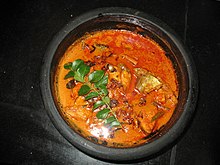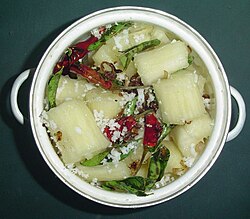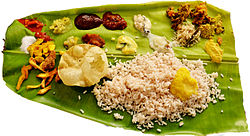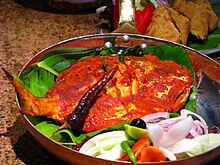Kerala cuisine
This article needs additional citations for verification. (May 2012) |
| This article is part of the series on |
| Indian cuisine |
|---|
 |
The cuisine of Kerala is linked in all its richness to the history, geography, demography and culture of the land. Kerala cuisine has a multitude of both vegetarian and non-vegetarian dishes prepared using fish, poultry and red meat.
Ingredients
Coconuts grow in abundance in Kerala, and consequently, coconut kernel, (sliced or grated) coconut cream and coconut milk are widely used in dishes for thickening and flavouring. Kerala's long coastline, numerous rivers and backwater networks, and strong fishing industry have contributed to many sea and river food based dishes. Rice and cassava (Tapioca) form the staple food of Kerala. All main dishes are made with them and served along with Kootan; the side dishes which may be made from vegetables, meat, fish or a mix of all of them. The main dish for lunch and dinner is boiled rice. The Kerala breakfast shows a rich variety; the main dishes for which are made from rice flour, or fresh or dried cassava. Owing to the weather and the availability of spices, the Kerala cuisine is richly spicy especially the hot ones -chili, black pepper, cardamom, cloves, ginger, and cinnamon.
Historical and cultural influences
For over 2000 years, Kerala has been visited by ocean-goers, including traders from Greece, Rome, the eastern Mediterranean, Arab countries, and Europe (see History of Kerala). Thus, Kerala cuisine is a blend of indigenous dishes and foreign dishes adapted to Kerala tastes.
Pre-independence Kerala was basically split into the princely states of Travancore & Kochi in the south, and Malabar district in the north; the erstwhile split is reflected in the recipes and cooking style of each area. Both Travancore and northern Malabar cuisine consists of a variety of vegetarian dishes using many vegetables and fruits that are not commonly used in curries elsewhere in India including plantains (Nenthrapazham or vazha-ppazham or ethaykka), bitter gourd ('pavaykka' in Travancore and 'kayappakka' in northern Malabar), Yam ('chena'), Colocasia ('chembu'), Ash gourd (Kumbalanga), etc. However, their style of preparation and names of the prepares dishes may vary. Northern Malabar has an array of vegetarian and non-vegetarian dishes such as pathiri (a sort of rice-based pancake, at times paired with a meat curry), porotta (a layered flatbread, said to come from south east Asia), and the Kerala variant of the popular biriyani, from north India/Pakistan. Travancore region boasts of a parade of dishes like appam that is largely identified with the Saint Thomas Christians (also known as Syrian Christians or Nasrani) of the region.
In addition to historical diversity, the cultural influences, particularly the large percentages of Muslims and Syrian Christians have also contributed unique dishes and styles to Kerala cuisine, especially non-vegetarian dishes. The meat eating habit of the people have been historically limited by religious taboos. Brahmins eschew non vegetarian items. However, most of modern day Hindus do not observe any dietary taboos, except a few of those belonging to upper caste.[1] Muslims do not eat pork and other items forbidden by Islamic law.
Historically, Kerala was part of the Tamil-speaking area, and Tamilian influence is seen in the popularity of sambar, idli and dosa. European influence is reflected in the numerous bakeries selling cakes, cream horns, and Western-style yeast-leavened bread, and in Anglo-Indian cuisine. The import of potatoes, tomatoes, and chili peppers from the Americas led to their enthusiastic use in Kerala, although except for the ubiquitous peppers, the other ingredients are used more sparingly.
Malabar Cuisines

One of the main special cuisine is the Malabar biryani the dish is famed for its exquisite taste and aroma.[2] Usuallly chicken is preferred as an ingredient but variants of mutton and egg is also experimented. Cuisines of Kallummakaya (Green mussel) is another specialty. Numerous dishes like Arikkadukka are made out of it. The region is blessed with large availability of Fresh Prawns, Shrimp, Crab, Mussels e.t.c. [3] The filled foods like kai nirachathu, are some of the exotic dishes that people from other regions will find. The cuisines of exotic nature are mainly Mappila in origin. There are innumerable variety of dishes main course and snacks made by the people in the region. The variety will be evident during the Ramzan season.
Spices in Kerala Cuisine
As with almost all Indian food, spices play an important part in Kerala cuisine. The main spices used are cinnamon, cardamom, ginger, green and red peppers, cloves, garlic, cumin seeds, coriander, turmeric, and so on. Few fresh herbs are used, unlike in European cuisine, and mainly consist of the commonly used curry leaf, and the occasional use of fresh coriander and mint. While Tamarind and lime are used to make sauces sour in North Malabar areas; the Travancore region uses only kodampuli (Garcinia cambogia), as sour sauces are very popular in Kerala. Sweet and sour dishes are however, rare, but exceptions like the ripe mango version of the pulissery and tamarind-jaggery-ginger chutney known as puliinji or injipuliwhich is also known as Sou Ginger are popular.
Mealtimes
Breakfast

Kerala cuisine offers many delicious vegetarian breakfast dishes that are often relatively unknown outside the state. These include Puttu (made of rice powder and grated coconut, steamed in a metal or bamboo holder) and kadala (a curry made of black garbanzo beans chana), idli (fluffy rice pancakes), sambar, dosa and chutney, pidiyan, Idiyappam (string hoppers - also known as Noolputtu and Nool-Appam (or Idunni) in Malabar), Paal-Appam, a circular, fluffy, crisp-edged pancake made of rice flour fermented with a small amount of toddy or wine, etc. Idiyappam and Paalappam are accompanied by mutton, chicken or vegetable stew or fish moli (the most common dish is pearl spot in a coconut based sauce). In North Malabar area,breakfast is known is Kathaladakkal and Praathal in rest of Kerala.Most importantly almost all the dishes of kerala uses coconut oil for cooking purposes.
Lunch and dinner
Kerala's own cuisine-Sadya: Sadya is the most famous main course food of Kerala, probably Kerala's own. It is receipe with a set of curries with Kerala rice(boiled rice) along with sambar, parippukari with ghee, pachadi, kichadi, aviyal, puliyan, kuttukari, Kalan, Olan, Injikkari, rasam, pappadam, pickle, raita, sweetners(two or three different types), payasam. The dish will be more than satisfactory, however expert hands are necessary for cooking as a slight mistake will spoil the taste of the dish.
Kerala biryani: Popularly known as Malabar biryani or Thalassery biryani. This is the only biriyani variant of Kerala so it can be called Kerala biryani. Thalassery biryani is a famous dish all over Kerala for it's exquisite taste and aroma. The speciality of this biriyani when compared to the other biryani variants is the choice of rice(Khaima rice and not Basmati) and the method of preparation. This creates a new variant of biryani which tastes much different than the other variants.
The staple food of Kerala, like most South-Indian states, is rice. Unlike other states, however, many people in Kerala prefer parboiled rice (Choru) (rice made nutritious by boiling it with rice husk). Kanji (rice congee), a kind of rice porridge, is also popular. Tapioca, called Kappa in Kerala, is popular in central Kerala and in the highlands, and is frequently eaten with fish curry or beef curry.

Rice is usually consumed with one or more curries. Accompaniments with rice may include upperis (dry braised or sauteed vegetables), rasam, chips, and/or buttermilk (called moru). Vegetarian dinners usually consist of multiple courses, each involving rice, one main dish (usually sambar, rasam, puli-sherry), and one or more side-dishes. Kerala cooking uses coconut oil almost exclusively, although health concerns and cost have led to coconut oil being replaced to some extent by palm oil and vegetable oil.
Popular vegetarian dishes include sambar, aviyal, Kaalan, thoran, (Poduthol (dry curry), pulisherry (morozhichathu in Cochin and the Malabar region), olan, erisherry, puliinji, cherupayaru (mung bean), kappa (tapioca), etc. Vegetarian dishes often consist of fresh spices that are liquefied and crushed to make a paste-like texture to dampen rice.
Common non-vegetarian dishes include stew (using chicken, mutton, fish), traditional or chicken curry (Nadan Kozhi Curry), chicken fry (Kozhi Porichathu/Varuthathu), beef fry, fish/chicken/mutton molly(fish or meat in light gravy), fish curry (Meen Curry), fish fry (Meen Porichathu/Varuthathu), prawn fry (Konchu Varuthathu), Spicy Steamed Fish (Meen Pollichathu) etc.
Although rice and tapioca may be considered the original Kerala starch staples, wheat, in the form of chappatis or parathas (known as porottas in Kerala), is now very commonly eaten, especially at dinner time. Numerous little streetside vendors offer an oily paratha (akin to the croissant in its flakiness and oiliness) with meat, egg, or vegetable curry for dinner. Grains such as ragi and millet, although common in the arid parts of South India, have not gained a foothold in Kerala.
Malabar Biriyani is one of the tasty non vegetarian dishes in North Kerala. The main variants are Thalassery biriyani and Kozhikode biryani. The speciality is that Malabar biriyani use Khyma rice and do not use basmati for preparation.[4]
For the main article see Sadya


Kerala is known for its traditional banquet or sadhya, a vegetarian meal served with boiled rice and a host of side-dishes served especially during special occasions and festivals. The sadhya is complemented by payasam, a sweet dessert native to Kerala. The sadhya is, as per custom, served on a banana leaf, and is a formal-style meal with three or more courses of rice with a side-dish (usually sambar, rasam, buttermilk, etc.). In south Kerala the Payasam in followed by more (butter milk) and rasam whereas in North Malabar it is considered to be the last dish to be served. A typical sadhya would have
- Boiled Rice
- Sambar
- Parippu
- Aviyal
- Kaalan
- Pachadi
- Kichadi
- Poduthol
- Thoran
- Pulisherry
- Olan
- Puliinji
- Pappadam
- Mooru
- Kaya upperi
- Sharkara upperi
- Achar Pickle
- Banana
- Paayasam
Sweets and Desserts

Kerala does not have any indigenous cold desserts, but hot/warm desserts are popular. The most popular example is undoubtedly the payasam: a preparation of milk, coconut extract, sugar, cashews, dry grapes, etc. Payasam can be made with many base constituents, including Paal payasam (made from rice), Ada payasam (with Ada, broken strips of baked starch from various sources), ari unda (made from rice powder) 'Parippu payasam (made from dal), Pazham pradhaman (made from banana), Gothambu payasam (made from wheat) etc. Ada payasam is especially popular during the festival of Vishu and Onam. Most payasams can also be consumed chilled. Jaggery or molasses is a common sweetening ingredient, although white sugar is gaining ground. Fruit, especially the small yellow bananas, are often eaten after a meal or at any time of the day. Plantains, uncooked or steamed, are popularly eaten for breakfast or tea.
Other popular sweets include Unniappam (fried rice cake), pazham-pori/ethakka-appam (plantain slices covered with a fried crust made of sweetened flour), kozhakkatta (rice dumplings stuffed with a sweet mixture of molasses, coconut etc.) and ilayappam (rice, jaggery and coconut mixture covered in banana leaf). Cakes, ice-creams, cookies and puddings are equally common. Generally, except for payasam, most sweets are not eaten as dessert but as a tea-time snack.

Pickles and other side-dishes
Kerala cuisine also has a variety of pickles and chutneys, and crunchy pappadums, banana chips, jackfruit chips, pakka vada (crunchy gram and rice flour chips), Kalathappam, Kinnathappam kozhalappam, achappam, cheeda, and churuttu.
Beverages
Being mostly a hot and humid area, Keralites have developed a variety of drinks to cope with thirst. A variety of what might be called herbal teas are served during mealtimes. Cumin seeds, ginger or coriander seeds are boiled in water and served warm or at room temperature. In addition to the improved taste, the spices also have digestive and other medicinal properties. Sambharam, a diluted buttermilk often flavoured with ginger, lime leaves, green chili peppers etc. was very commonly drunk, although it has been replaced to some extent by soda pop. Coffee and tea (both hot) drunk black, or with milk and white sugar or unrefined palm sugar (karippatti), are commonly drunk. Numerous small shops dotted around the land sell fresh lime juice (called naranga vellam, or bonji sarbat in Malayalam), and many now offer milk shakes and other fruit juices. Tender Coconut water is also a very popular beverage in Kerala.
Cooking Utensils
There are utensils that are used in Kerala which are significant to cuisine in Kerala. An aduppu is a square hearth, Mun Chatti is cooking pot made from clay, Cheena Chatti (literally Chinese pot) is a deep frying pan, a wok.
Food offerings in rituals
Food is extremely important when it comes to rituals or festivals. Food offerings in ritual are important in Kerala and throughout South India. Food offerings are often related to the gods of religions. In India, there are numerous offerings for Hindu gods and there are many differences between food offerings in North and South India. Most offerings contain more than one type of food. There are many reasons why people use the practice of food offerings. Some are to express love, or negotiate or thank gods. It can also be used to "stress certain structural features of Hinduism".[5] Of course, not every ritual’s gods require food offerings. Most have a liking for certain foods. For example, butter is one of the preferred foods by the god Krishna. Also, wild orange and a sugarcane stalk are related to Ganapati.[6]
There is a division of the Hindu pantheon into pure and impure deities which is stressed, but shaped by food offerings. Pure deities are offered vegetarian foods while impure deities are offered meat due to their craving for blood.[7] A specific dish is offered to both pure and impure deities. That is a flour lamp which is made of sweetened rice-flour paste which is scooped out and packed with ghee. The flour lamp is only partially baked and then eaten.[8] Another aspect of food offerings is the hierarchy that foods have. It may seem strange that there is a hierarchy for foods, but it is because there is a dual opposition between the pure and impure deities which is hierarchal.[9] There are two gods which have this dual opposition. They are Vishnu and Siva. Ferro-Luzzi explains that Vishnu is viewed as kind while the offerings that are given to Siva are more frugal'. An offering to Siva might be likely to be plain rice with no salt or other toppings, while an offering to Vishnu may resemble a South Indian dish which can consist of rice with other side dishes. Specifically in South Indian offerings, they are offered in numbers. For example, the number three is important in Kerala offerings. There are the trimadhura which translates into 'the three sweets'.[10] All of these practices of food offerings in ritual are important in Kerala culture as well as South Indian culture.
Cooking as sacred ritual
The last decade has seen the rise of cooking as sacred ritual in South Kerala, almost exclusively by women. This practice, called 'Pongala' (derived from Tamil dish Pongal), seems to have been historically associated with the Attukal Temple in Trivandrum city which was begotten from Tamil tradition. According to the Guinness Book of Records, Attukal Pongala is the largest gathering of women in the world.[11] Women participants of the pongala come equipped with cooking pots, dry fuel (mostly dry leaves and spathes of the coconut palm) and ingredients such as rice flour, palm sugar and condiments, often the previous evening, and set up their hearths around the temple on the morning of the day of the festival.
Often, the women take over most of the roads and lanes of Trivandrum city during the pongala day. In 2009, the estimated number of women who participated was 2.5 million.[12] The women wait until the Attukal temple ceremoniously distributes the fire, and set about their cooking when the fire reaches them, passed from hearth to hearth. They go home with the cooked offerings by late afternoon. While males are not allowed in the area, they help out my providing support to arriving and departing women by organising transportation, and distributing free beverages. Trivandrum city, police and civil authorities have been successfully able to manage the festival, but it is quintessentially a women's festival.
Despite the lack of amenities, the considerable hardship involved in transportation of cooking equipment and ingredients (many women come from 30–40 km away), and the blazing February sun, the numbers of participants seem to be rising year after year, and include some of the well-known faces from cinema, social circles as well as commoners.
It is also observed that the practice of pongala is rapidly spreading to many other temples in Trivandrum city and district.
Cuisine of the Saint Thomas Christians
A favourite dish of Syrian Christians (Nasrani) is stew. Chicken, potatoes and onions simmered gently in a creamy white sauce flavoured with black pepper, cinnamon, cloves, green chillies, lime juice, shallots and coconut milk.[13]and thei r food comprises of coconut and sea food
They also prepare stews with chicken, lamb and duck.[13]
Other dishes include piralen (chicken stir-fries), meat thoran (dry curry with shredded coconut), sardine and duck curries, and meen molee (spicy stewed fish).[13] This is eaten with another Nasrani dish known as appam. Appams, kallappams, or vellayappams are rice flour pancakes which have soft, thick white spongy centres and crisp, lace-like edges.[13] "Meen Mulakittathu" (fish in fiery red chilly sauce) is another favourite item.[13]
In addition to chicken and fish, Christians along with all Hindus and Muslims in Kerala also eat red meat. For example, erachi olathiathu is a mutton dish cooked with spices.[13]
Glossary of vegetables, fruits, spices and other food stuff
| English name | Malayalam name | Malayalam (മലയാളം) |
|---|---|---|
| Asafoetida | Kaayam | കായം |
| Ash gourd | Kumbalanga | കുമ്പളങ്ങ |
| Banana | Vazhapazham, Pazham(Generic usage) | വാഴപ്പഴം, പഴം |
| Bilimbi cucumber fruit | Irumban Puli or Chemmeen Puli | ഇരുമ്പൻപുളി/ ചെമ്മീൻപുളി |
| Bengal gram | Mani Kadala | മണിക്കടല |
| Bitter gourd | Kaipakka (Pavakka) | കൈപ്പക്ക(പാവക്ക) |
| Black pepper | Kurumulaku | കുരുമുളക് |
| Butter | Neyyu / Venna | നെയ്യ് / വെണ്ണ |
| Cabbage | Mottakkoosu | മൂട്ടക്കൂസ് |
| Cardamom | Elakkaya | ഏലക്കായ |
| Cashew nut | Kasuvandi, Andipparippu | കശുവണ്ടി, അണ്ടിപരിപ്പ് |
| Cheese | Paalkkatti | പാല്ക്കട്ടി |
| Chicken | Kozhi erachi | കോഴി ഇറച്ചി |
| Cinnamon | Karuvapatta | കറുവാപ്പട്ട |
| Clove | Karayampoo | കരയാമ്പു (ഗ്രാമ്പൂ) |
| Coconut oil | Velichenna | വെളിച്ചെണ്ണ |
| Coconut | Nalikeram, Thenga | നാളികേരം/തേങ്ങ |
| Coffee | Kaappi | കാപ്പി |
| Colocasia | Chembu | ചേമ്പു |
| Coriander | Malli or Kothamalli | മല്ലി / കൊത്തമല്ലി |
| Cowpea | Van Payar | വൻപയർ |
| Cucumber | Kakkiri or Kakkirikka | കക്കിരി/ കക്കിരിക്ക |
| Indian Yellow Cucumber | Vellarikka | വെളളരിക്ക |
| Cumin | Jeerakam | ജീരകം |
| Curd/ Yoghurt | Thairu | തൈര് |
| Egg | Mutta | മുട്ട |
| Egg plant / Brinjal | Vazhuthananga, kathirikka | വഴുതനങ്ങ, കത്തിരിക്ക |
| Fennel | Perumjeerakam | പെരുംജീരകം |
| Fenugreek | Uluva or Venthayam | ഉലുവ, വെന്തയം |
| Fish | Meen | മീന് |
| Garcinia cambogia | Kodampuli | കൊടമ്പുളി |
| Garlic | Veluthulli | വെളളുത്തുളളി |
| Ginger | Inji | ഇഞ്ജി |
| Indian Gooseberry (Amla / Emblica) | Nellikka | നെല്ലിക്ക |
| Green chili | Pacha mulaku | പച്ചമുളക് |
| Green gram | Cherupayar | ചെറുപയർ |
| Guava | Perakka, Poyyakka, Koyyakka | പേരയ്ക്ക |
| Jack fruit | Chakka | ചക്ക |
| Jaggery | Sarkara (bellam or vellam) | ശർക്കര(വെല്ലം,ബെല്ലം) |
| Lemon | Narrenga | നാരങ്ങ |
| Lime | Cherunarrenga | ചെറുനാരങ്ങ |
| Mango | Maanga | മാങ്ങ |
| Meat | Erachi | ഇറച്ചി |
| Meat - Lamb/Mutton | Aattu Erachi | ആട്ടിറച്ചി |
| Meat - Pork | Panni Erachi | പന്നി ഇറച്ചി |
| Milk | Paal | പാല് |
| Mint leaves | Puthina ela | പുതിനയില |
| Moringa Fruit (Drumstick) | Muringakkaya | മുരിങ്ങക്കായ |
| Mustard seeds | Kaduku | കടുകു |
| Nutmeg | Jathikka | ജാതിക്ക |
| Okra / Lady's finger | Vendakka | വെണ്ടയ്ക്ക |
| Onion | Ulli, Savala, Sabola | ഉളളി, സവോള, സബോള |
| Orange | Madhuranarrenga | മധുരനാരങ്ങ |
| Papaya | Karmosa, Omakaya, Kappakaya, Papakaya, Pappaya,Pappali, Kappalanga | പപ്പായ, കപ്പ്ളങ്ങ |
| Pea | Pattani, Pattani Kadala | കടല |
| Peanut / Groundnut | Kappalandi or Nilakkadala | കപ്പലണ്ടി |
| Pigeon pea / Red gram | Thoovara | തുവര |
| Pineapple | Kaithachakka | കൈതച്ചക്ക |
| Plantain(Raw) | Nendrakkaya, Ethekkya | നേന്ത്രക്കായ, ഏത്തക്കായ |
| Plantain(Ripe) | Nenthrapazham, Ethapazham | നേന്ത്രപ്പഴം, ഏത്തപ്പഴം |
| Potato | Urulakkizhangu | ഉരുളക്കിഴങ്ങ് |
| Pumpkin | Matthanga, Mathangumblam | മത്തങ്ങ |
| Raisin | Unakka munthiri, kismis | ഉണക്കമുന്തിരി |
| Saba Banana | Robust | റൊബസ്റ്റ |
| Salt | Uppu | ഉപ്പു |
| Shallot | Chuvannulli or Cheriyulli | ചുവന്നുളളി |
| Snake gourd | Padavalanga | പടവലങ്ങ |
| Sugar | Panjasara | പഞ്ജസാര |
| Tamarind | Pulli | പുളി |
| Tapioca / Cassava | Kolli, Kappa, Marichini, Poolakizhaghu | കൊളളി, കപ്പ, മരച്ചീനി, പൂളക്കിഴങ്ങ് |
| Taro | Cheambu | ചേമ്പു |
| Tea leaves | Theyila | തേയില |
| Tomato | Thakkali | തക്കാളി |
| Vigna mungo ( Black Gram / Urad ) | Uzhunnu | ഉഴുന്ന് |
| Water | Vellam | വെള്ളം |
| 'Waxy rose' water apple | Champa or Champakka | ചാമ്പ / ചാമ്പക്ക |
| Yam / Elephant Foot Yam | Chena | ചേന |
References
- ^ Social mobility in Kerala Kanjirathara Chandy Alexander
- ^ http://www.mysingaporekitchen.com/2012/11/thalassery-biriyani.html
- ^ http://blessingsonthenet.com/travel-india/destination/article/id/232/tour/id/41/cuisine-of-kannur
- ^ http://www.mysingaporekitchen.com/2012/11/thalassery-biriyani.html
- ^ (Ferro-Luzzi 1977, 508)
- ^ (Ferro-Luzzi 1977, 508)
- ^ (Ferro-Luzzi 1977, 509)
- ^ (Ferro-Luzzi 1977, 509)
- ^ (Ferro-Luzzi 1977, 509)
- ^ (Ferro-Luzzi 1977, 512)
- ^ http://www.guinnessworldrecords.com/news/2008/03/080304.aspx
- ^ Holy Cooking India Today - MARCH 19, 2007
- ^ a b c d e f Marks, Gil (2010), Encyclopedia of Jewish Food, John Wiley and sons
